University Accounting Report: Beztec Ltd Costing and Ethics Analysis
VerifiedAdded on 2023/06/04
|11
|2961
|420
Report
AI Summary
This report analyzes Beztec Ltd's financial data and costing methods, comparing traditional and activity-based costing. The report examines the impact of different costing methods on profitability analysis, specifically focusing on the Lexon and Protox printer models. It includes calculations of overhe...
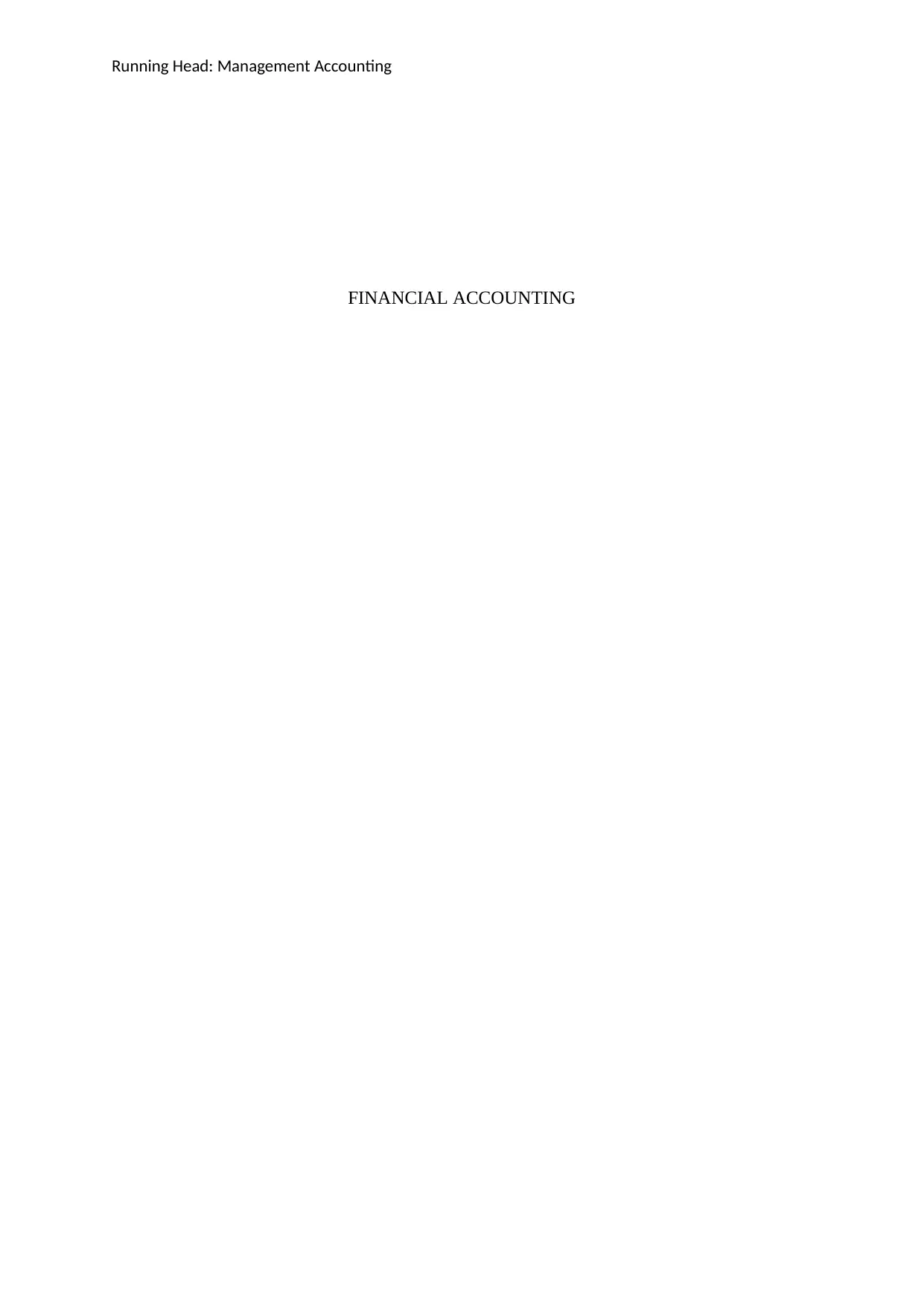
Running Head: Management Accounting
FINANCIAL ACCOUNTING
FINANCIAL ACCOUNTING
Paraphrase This Document
Need a fresh take? Get an instant paraphrase of this document with our AI Paraphraser
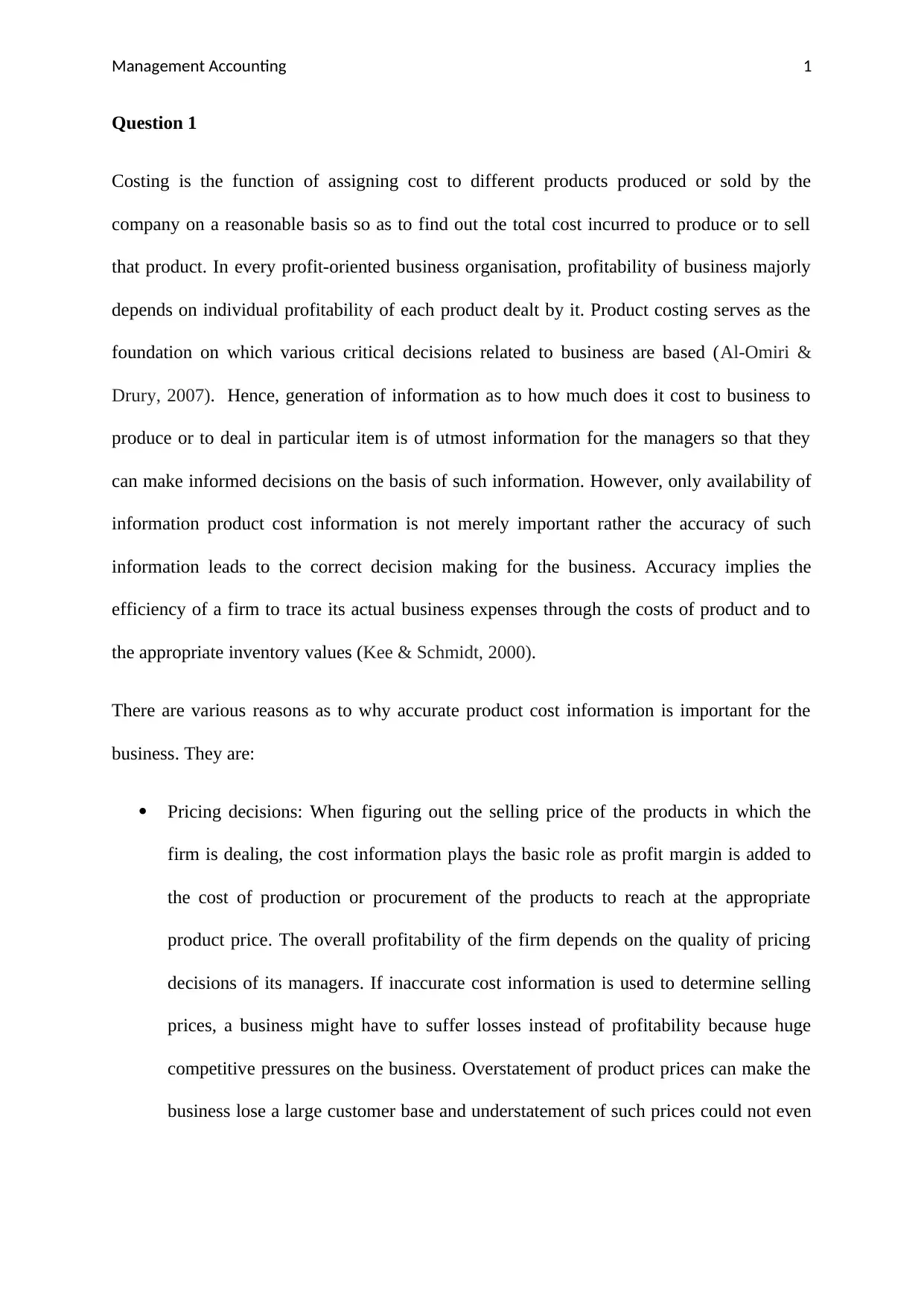
Management Accounting 1
Question 1
Costing is the function of assigning cost to different products produced or sold by the
company on a reasonable basis so as to find out the total cost incurred to produce or to sell
that product. In every profit-oriented business organisation, profitability of business majorly
depends on individual profitability of each product dealt by it. Product costing serves as the
foundation on which various critical decisions related to business are based (Al-Omiri &
Drury, 2007). Hence, generation of information as to how much does it cost to business to
produce or to deal in particular item is of utmost information for the managers so that they
can make informed decisions on the basis of such information. However, only availability of
information product cost information is not merely important rather the accuracy of such
information leads to the correct decision making for the business. Accuracy implies the
efficiency of a firm to trace its actual business expenses through the costs of product and to
the appropriate inventory values (Kee & Schmidt, 2000).
There are various reasons as to why accurate product cost information is important for the
business. They are:
Pricing decisions: When figuring out the selling price of the products in which the
firm is dealing, the cost information plays the basic role as profit margin is added to
the cost of production or procurement of the products to reach at the appropriate
product price. The overall profitability of the firm depends on the quality of pricing
decisions of its managers. If inaccurate cost information is used to determine selling
prices, a business might have to suffer losses instead of profitability because huge
competitive pressures on the business. Overstatement of product prices can make the
business lose a large customer base and understatement of such prices could not even
Question 1
Costing is the function of assigning cost to different products produced or sold by the
company on a reasonable basis so as to find out the total cost incurred to produce or to sell
that product. In every profit-oriented business organisation, profitability of business majorly
depends on individual profitability of each product dealt by it. Product costing serves as the
foundation on which various critical decisions related to business are based (Al-Omiri &
Drury, 2007). Hence, generation of information as to how much does it cost to business to
produce or to deal in particular item is of utmost information for the managers so that they
can make informed decisions on the basis of such information. However, only availability of
information product cost information is not merely important rather the accuracy of such
information leads to the correct decision making for the business. Accuracy implies the
efficiency of a firm to trace its actual business expenses through the costs of product and to
the appropriate inventory values (Kee & Schmidt, 2000).
There are various reasons as to why accurate product cost information is important for the
business. They are:
Pricing decisions: When figuring out the selling price of the products in which the
firm is dealing, the cost information plays the basic role as profit margin is added to
the cost of production or procurement of the products to reach at the appropriate
product price. The overall profitability of the firm depends on the quality of pricing
decisions of its managers. If inaccurate cost information is used to determine selling
prices, a business might have to suffer losses instead of profitability because huge
competitive pressures on the business. Overstatement of product prices can make the
business lose a large customer base and understatement of such prices could not even
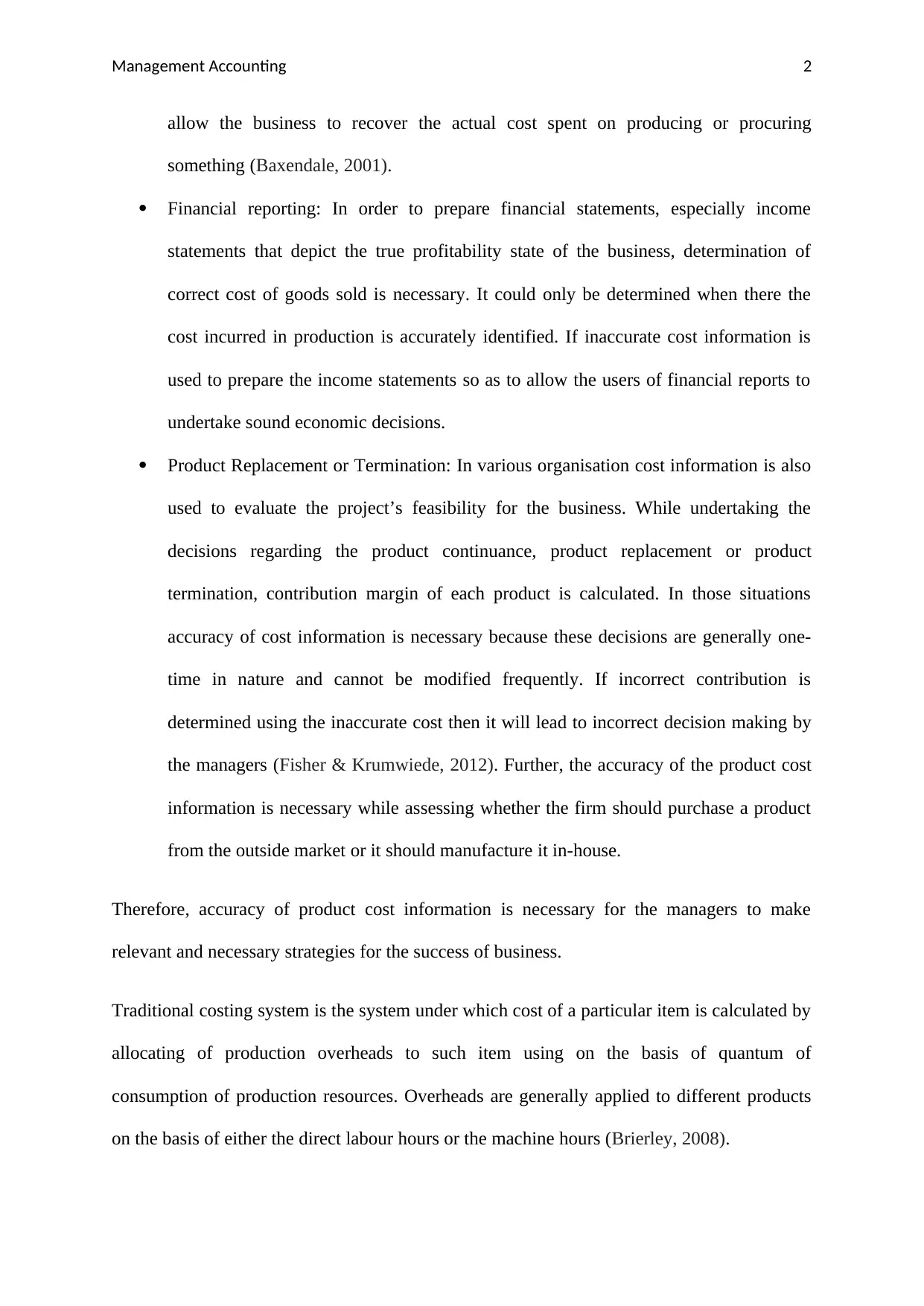
Management Accounting 2
allow the business to recover the actual cost spent on producing or procuring
something (Baxendale, 2001).
Financial reporting: In order to prepare financial statements, especially income
statements that depict the true profitability state of the business, determination of
correct cost of goods sold is necessary. It could only be determined when there the
cost incurred in production is accurately identified. If inaccurate cost information is
used to prepare the income statements so as to allow the users of financial reports to
undertake sound economic decisions.
Product Replacement or Termination: In various organisation cost information is also
used to evaluate the project’s feasibility for the business. While undertaking the
decisions regarding the product continuance, product replacement or product
termination, contribution margin of each product is calculated. In those situations
accuracy of cost information is necessary because these decisions are generally one-
time in nature and cannot be modified frequently. If incorrect contribution is
determined using the inaccurate cost then it will lead to incorrect decision making by
the managers (Fisher & Krumwiede, 2012). Further, the accuracy of the product cost
information is necessary while assessing whether the firm should purchase a product
from the outside market or it should manufacture it in-house.
Therefore, accuracy of product cost information is necessary for the managers to make
relevant and necessary strategies for the success of business.
Traditional costing system is the system under which cost of a particular item is calculated by
allocating of production overheads to such item using on the basis of quantum of
consumption of production resources. Overheads are generally applied to different products
on the basis of either the direct labour hours or the machine hours (Brierley, 2008).
allow the business to recover the actual cost spent on producing or procuring
something (Baxendale, 2001).
Financial reporting: In order to prepare financial statements, especially income
statements that depict the true profitability state of the business, determination of
correct cost of goods sold is necessary. It could only be determined when there the
cost incurred in production is accurately identified. If inaccurate cost information is
used to prepare the income statements so as to allow the users of financial reports to
undertake sound economic decisions.
Product Replacement or Termination: In various organisation cost information is also
used to evaluate the project’s feasibility for the business. While undertaking the
decisions regarding the product continuance, product replacement or product
termination, contribution margin of each product is calculated. In those situations
accuracy of cost information is necessary because these decisions are generally one-
time in nature and cannot be modified frequently. If incorrect contribution is
determined using the inaccurate cost then it will lead to incorrect decision making by
the managers (Fisher & Krumwiede, 2012). Further, the accuracy of the product cost
information is necessary while assessing whether the firm should purchase a product
from the outside market or it should manufacture it in-house.
Therefore, accuracy of product cost information is necessary for the managers to make
relevant and necessary strategies for the success of business.
Traditional costing system is the system under which cost of a particular item is calculated by
allocating of production overheads to such item using on the basis of quantum of
consumption of production resources. Overheads are generally applied to different products
on the basis of either the direct labour hours or the machine hours (Brierley, 2008).
⊘ This is a preview!⊘
Do you want full access?
Subscribe today to unlock all pages.

Trusted by 1+ million students worldwide
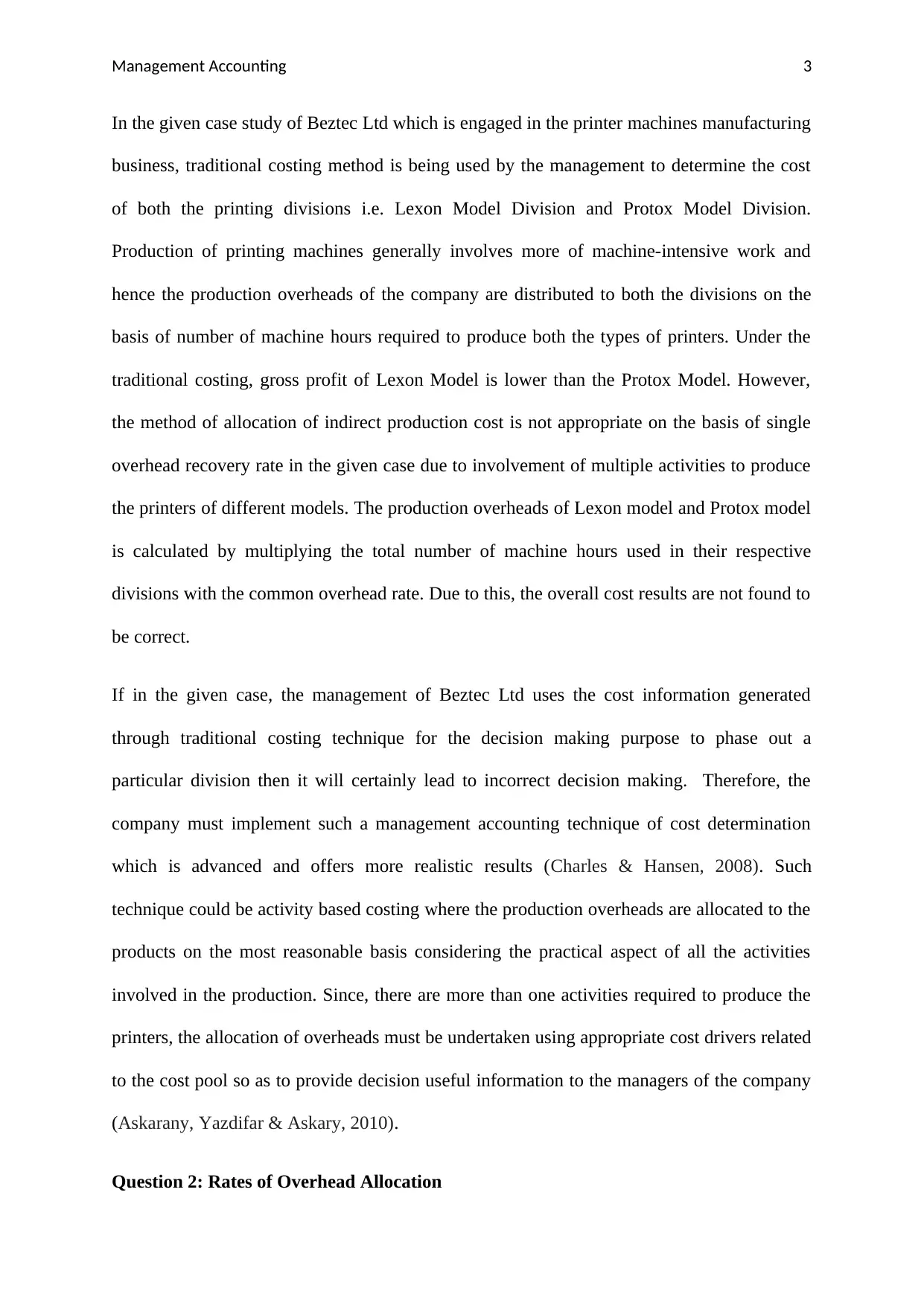
Management Accounting 3
In the given case study of Beztec Ltd which is engaged in the printer machines manufacturing
business, traditional costing method is being used by the management to determine the cost
of both the printing divisions i.e. Lexon Model Division and Protox Model Division.
Production of printing machines generally involves more of machine-intensive work and
hence the production overheads of the company are distributed to both the divisions on the
basis of number of machine hours required to produce both the types of printers. Under the
traditional costing, gross profit of Lexon Model is lower than the Protox Model. However,
the method of allocation of indirect production cost is not appropriate on the basis of single
overhead recovery rate in the given case due to involvement of multiple activities to produce
the printers of different models. The production overheads of Lexon model and Protox model
is calculated by multiplying the total number of machine hours used in their respective
divisions with the common overhead rate. Due to this, the overall cost results are not found to
be correct.
If in the given case, the management of Beztec Ltd uses the cost information generated
through traditional costing technique for the decision making purpose to phase out a
particular division then it will certainly lead to incorrect decision making. Therefore, the
company must implement such a management accounting technique of cost determination
which is advanced and offers more realistic results (Charles & Hansen, 2008). Such
technique could be activity based costing where the production overheads are allocated to the
products on the most reasonable basis considering the practical aspect of all the activities
involved in the production. Since, there are more than one activities required to produce the
printers, the allocation of overheads must be undertaken using appropriate cost drivers related
to the cost pool so as to provide decision useful information to the managers of the company
(Askarany, Yazdifar & Askary, 2010).
Question 2: Rates of Overhead Allocation
In the given case study of Beztec Ltd which is engaged in the printer machines manufacturing
business, traditional costing method is being used by the management to determine the cost
of both the printing divisions i.e. Lexon Model Division and Protox Model Division.
Production of printing machines generally involves more of machine-intensive work and
hence the production overheads of the company are distributed to both the divisions on the
basis of number of machine hours required to produce both the types of printers. Under the
traditional costing, gross profit of Lexon Model is lower than the Protox Model. However,
the method of allocation of indirect production cost is not appropriate on the basis of single
overhead recovery rate in the given case due to involvement of multiple activities to produce
the printers of different models. The production overheads of Lexon model and Protox model
is calculated by multiplying the total number of machine hours used in their respective
divisions with the common overhead rate. Due to this, the overall cost results are not found to
be correct.
If in the given case, the management of Beztec Ltd uses the cost information generated
through traditional costing technique for the decision making purpose to phase out a
particular division then it will certainly lead to incorrect decision making. Therefore, the
company must implement such a management accounting technique of cost determination
which is advanced and offers more realistic results (Charles & Hansen, 2008). Such
technique could be activity based costing where the production overheads are allocated to the
products on the most reasonable basis considering the practical aspect of all the activities
involved in the production. Since, there are more than one activities required to produce the
printers, the allocation of overheads must be undertaken using appropriate cost drivers related
to the cost pool so as to provide decision useful information to the managers of the company
(Askarany, Yazdifar & Askary, 2010).
Question 2: Rates of Overhead Allocation
Paraphrase This Document
Need a fresh take? Get an instant paraphrase of this document with our AI Paraphraser

Management Accounting 4
Activity Pool Overheads Lexon
Proto
x Total Rate
Soldering Cost
$
1,165,725.00
No. of Solder
Points
13331
25
4331
25
17662
50
$
0.66
Shipment Cost
$
1,064,250.00
No. of
Shipments 18225 4275 22500
$
47.30
Quality Control
$
1,534,500.00
No. of
inspections 63225 2396
3 87188
$
17.60
Purchase Cost
$
1,176,120.00 No. of orders 90113 1237
27
21384
0
$
5.50
Machine Power
Costs
$
71,280.00 Machine-hours
19800
0
1800
0
21600
0
$
0.33
Machine Set up
Costs
$
928,125.00 No. of set-ups 18000 1575
0 33750
$
27.50
$
5,940,000.00
Question 3: Determination of total production overheads:
Activity Pool
Lexon’s Cost
Drivers Amount
Protox’s
Cost
Drivers
Soldering Cost 1333125 $
879,862.50 433125 $
285,862.50
Shipment Cost 18225 $
862,042.50 4275 $
202,207.50
Quality Control 63225 $
1,112,753.62 23963 $
421,746.38
Purchase Cost 90113 $
495,621.50 123727 $
680,498.50
Machine Power Costs 198000 $
65,340.00 18000 $
5,940.00
Machine Set up Costs 18000 $
495,000.00 15750 $
433,125.00
Total Production
Overheads
$
3,910,620.12
$
2,029,379.88
Question 4: Profitability Analysis
Lexon Protox
Sales $ 23,760,000.00 $ 7,524,000.00
Total cost of goods sold $ 13,678,620.12 $ 6,636,179.88
Gross Profit $ 10,081,379.88 $ 887,820.12
GP % (Gross 42.43% 11.80%
Activity Pool Overheads Lexon
Proto
x Total Rate
Soldering Cost
$
1,165,725.00
No. of Solder
Points
13331
25
4331
25
17662
50
$
0.66
Shipment Cost
$
1,064,250.00
No. of
Shipments 18225 4275 22500
$
47.30
Quality Control
$
1,534,500.00
No. of
inspections 63225 2396
3 87188
$
17.60
Purchase Cost
$
1,176,120.00 No. of orders 90113 1237
27
21384
0
$
5.50
Machine Power
Costs
$
71,280.00 Machine-hours
19800
0
1800
0
21600
0
$
0.33
Machine Set up
Costs
$
928,125.00 No. of set-ups 18000 1575
0 33750
$
27.50
$
5,940,000.00
Question 3: Determination of total production overheads:
Activity Pool
Lexon’s Cost
Drivers Amount
Protox’s
Cost
Drivers
Soldering Cost 1333125 $
879,862.50 433125 $
285,862.50
Shipment Cost 18225 $
862,042.50 4275 $
202,207.50
Quality Control 63225 $
1,112,753.62 23963 $
421,746.38
Purchase Cost 90113 $
495,621.50 123727 $
680,498.50
Machine Power Costs 198000 $
65,340.00 18000 $
5,940.00
Machine Set up Costs 18000 $
495,000.00 15750 $
433,125.00
Total Production
Overheads
$
3,910,620.12
$
2,029,379.88
Question 4: Profitability Analysis
Lexon Protox
Sales $ 23,760,000.00 $ 7,524,000.00
Total cost of goods sold $ 13,678,620.12 $ 6,636,179.88
Gross Profit $ 10,081,379.88 $ 887,820.12
GP % (Gross 42.43% 11.80%
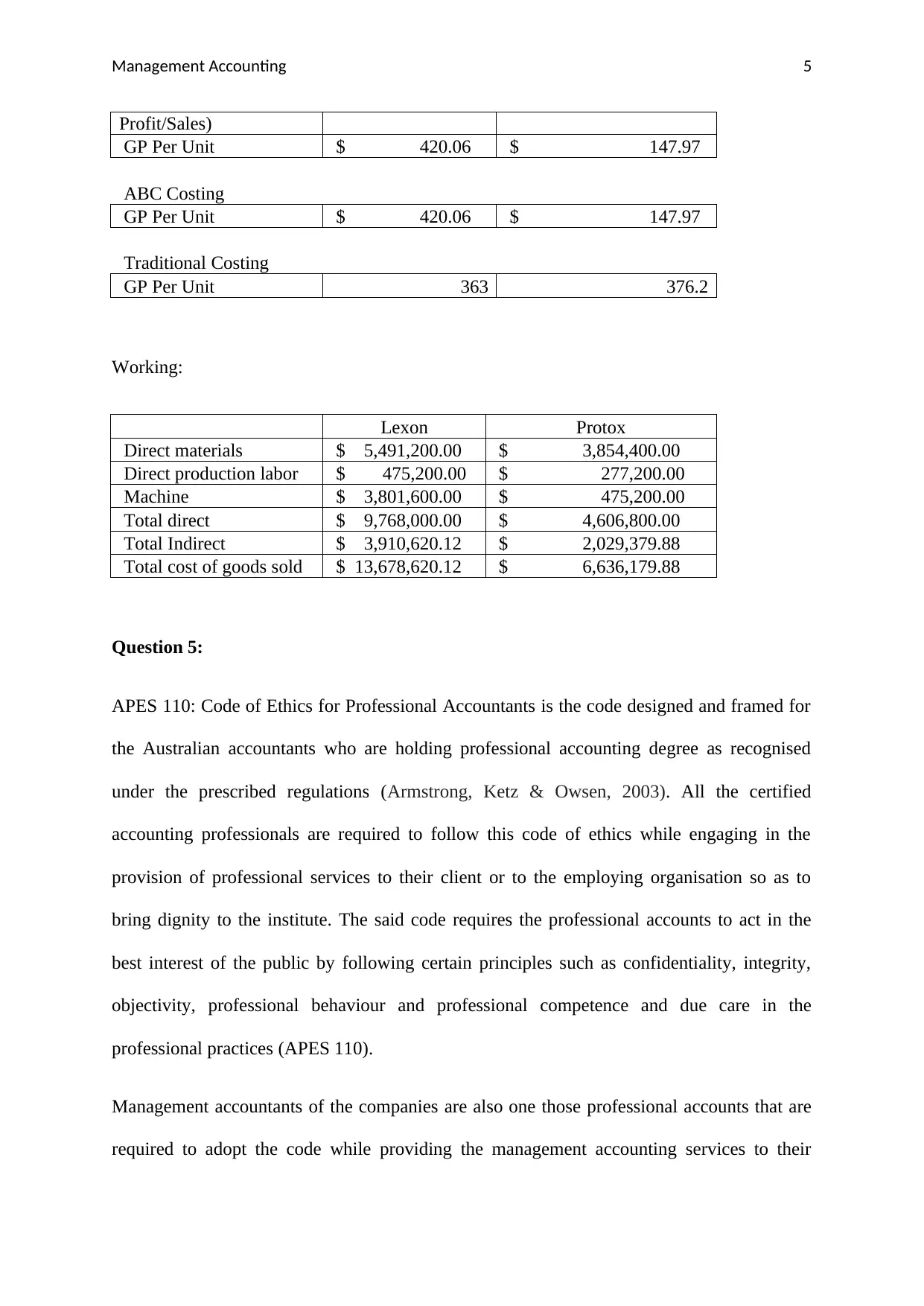
Management Accounting 5
Profit/Sales)
GP Per Unit $ 420.06 $ 147.97
ABC Costing
GP Per Unit $ 420.06 $ 147.97
Traditional Costing
GP Per Unit 363 376.2
Working:
Lexon Protox
Direct materials $ 5,491,200.00 $ 3,854,400.00
Direct production labor $ 475,200.00 $ 277,200.00
Machine $ 3,801,600.00 $ 475,200.00
Total direct $ 9,768,000.00 $ 4,606,800.00
Total Indirect $ 3,910,620.12 $ 2,029,379.88
Total cost of goods sold $ 13,678,620.12 $ 6,636,179.88
Question 5:
APES 110: Code of Ethics for Professional Accountants is the code designed and framed for
the Australian accountants who are holding professional accounting degree as recognised
under the prescribed regulations (Armstrong, Ketz & Owsen, 2003). All the certified
accounting professionals are required to follow this code of ethics while engaging in the
provision of professional services to their client or to the employing organisation so as to
bring dignity to the institute. The said code requires the professional accounts to act in the
best interest of the public by following certain principles such as confidentiality, integrity,
objectivity, professional behaviour and professional competence and due care in the
professional practices (APES 110).
Management accountants of the companies are also one those professional accounts that are
required to adopt the code while providing the management accounting services to their
Profit/Sales)
GP Per Unit $ 420.06 $ 147.97
ABC Costing
GP Per Unit $ 420.06 $ 147.97
Traditional Costing
GP Per Unit 363 376.2
Working:
Lexon Protox
Direct materials $ 5,491,200.00 $ 3,854,400.00
Direct production labor $ 475,200.00 $ 277,200.00
Machine $ 3,801,600.00 $ 475,200.00
Total direct $ 9,768,000.00 $ 4,606,800.00
Total Indirect $ 3,910,620.12 $ 2,029,379.88
Total cost of goods sold $ 13,678,620.12 $ 6,636,179.88
Question 5:
APES 110: Code of Ethics for Professional Accountants is the code designed and framed for
the Australian accountants who are holding professional accounting degree as recognised
under the prescribed regulations (Armstrong, Ketz & Owsen, 2003). All the certified
accounting professionals are required to follow this code of ethics while engaging in the
provision of professional services to their client or to the employing organisation so as to
bring dignity to the institute. The said code requires the professional accounts to act in the
best interest of the public by following certain principles such as confidentiality, integrity,
objectivity, professional behaviour and professional competence and due care in the
professional practices (APES 110).
Management accountants of the companies are also one those professional accounts that are
required to adopt the code while providing the management accounting services to their
⊘ This is a preview!⊘
Do you want full access?
Subscribe today to unlock all pages.

Trusted by 1+ million students worldwide
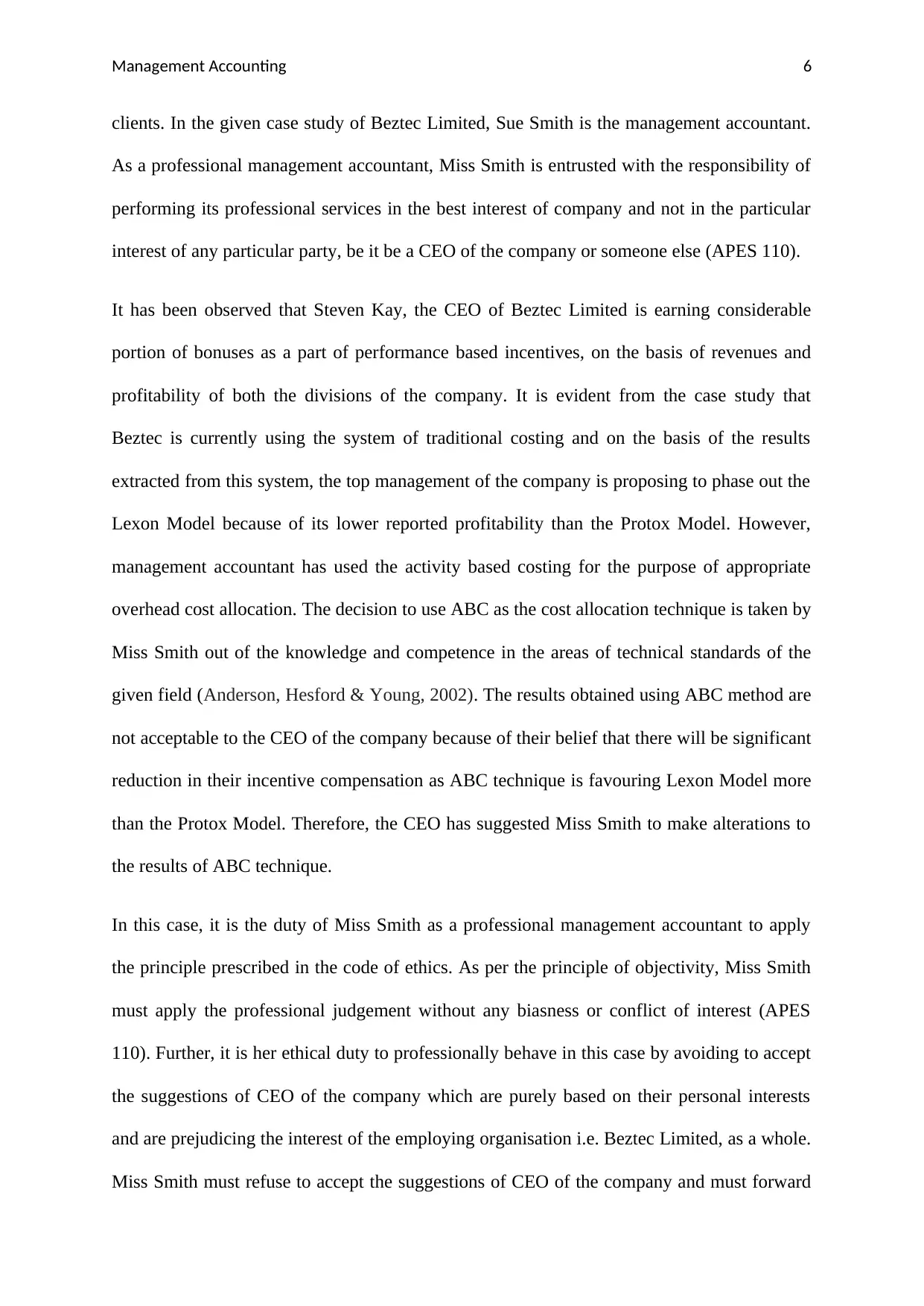
Management Accounting 6
clients. In the given case study of Beztec Limited, Sue Smith is the management accountant.
As a professional management accountant, Miss Smith is entrusted with the responsibility of
performing its professional services in the best interest of company and not in the particular
interest of any particular party, be it be a CEO of the company or someone else (APES 110).
It has been observed that Steven Kay, the CEO of Beztec Limited is earning considerable
portion of bonuses as a part of performance based incentives, on the basis of revenues and
profitability of both the divisions of the company. It is evident from the case study that
Beztec is currently using the system of traditional costing and on the basis of the results
extracted from this system, the top management of the company is proposing to phase out the
Lexon Model because of its lower reported profitability than the Protox Model. However,
management accountant has used the activity based costing for the purpose of appropriate
overhead cost allocation. The decision to use ABC as the cost allocation technique is taken by
Miss Smith out of the knowledge and competence in the areas of technical standards of the
given field (Anderson, Hesford & Young, 2002). The results obtained using ABC method are
not acceptable to the CEO of the company because of their belief that there will be significant
reduction in their incentive compensation as ABC technique is favouring Lexon Model more
than the Protox Model. Therefore, the CEO has suggested Miss Smith to make alterations to
the results of ABC technique.
In this case, it is the duty of Miss Smith as a professional management accountant to apply
the principle prescribed in the code of ethics. As per the principle of objectivity, Miss Smith
must apply the professional judgement without any biasness or conflict of interest (APES
110). Further, it is her ethical duty to professionally behave in this case by avoiding to accept
the suggestions of CEO of the company which are purely based on their personal interests
and are prejudicing the interest of the employing organisation i.e. Beztec Limited, as a whole.
Miss Smith must refuse to accept the suggestions of CEO of the company and must forward
clients. In the given case study of Beztec Limited, Sue Smith is the management accountant.
As a professional management accountant, Miss Smith is entrusted with the responsibility of
performing its professional services in the best interest of company and not in the particular
interest of any particular party, be it be a CEO of the company or someone else (APES 110).
It has been observed that Steven Kay, the CEO of Beztec Limited is earning considerable
portion of bonuses as a part of performance based incentives, on the basis of revenues and
profitability of both the divisions of the company. It is evident from the case study that
Beztec is currently using the system of traditional costing and on the basis of the results
extracted from this system, the top management of the company is proposing to phase out the
Lexon Model because of its lower reported profitability than the Protox Model. However,
management accountant has used the activity based costing for the purpose of appropriate
overhead cost allocation. The decision to use ABC as the cost allocation technique is taken by
Miss Smith out of the knowledge and competence in the areas of technical standards of the
given field (Anderson, Hesford & Young, 2002). The results obtained using ABC method are
not acceptable to the CEO of the company because of their belief that there will be significant
reduction in their incentive compensation as ABC technique is favouring Lexon Model more
than the Protox Model. Therefore, the CEO has suggested Miss Smith to make alterations to
the results of ABC technique.
In this case, it is the duty of Miss Smith as a professional management accountant to apply
the principle prescribed in the code of ethics. As per the principle of objectivity, Miss Smith
must apply the professional judgement without any biasness or conflict of interest (APES
110). Further, it is her ethical duty to professionally behave in this case by avoiding to accept
the suggestions of CEO of the company which are purely based on their personal interests
and are prejudicing the interest of the employing organisation i.e. Beztec Limited, as a whole.
Miss Smith must refuse to accept the suggestions of CEO of the company and must forward
Paraphrase This Document
Need a fresh take? Get an instant paraphrase of this document with our AI Paraphraser
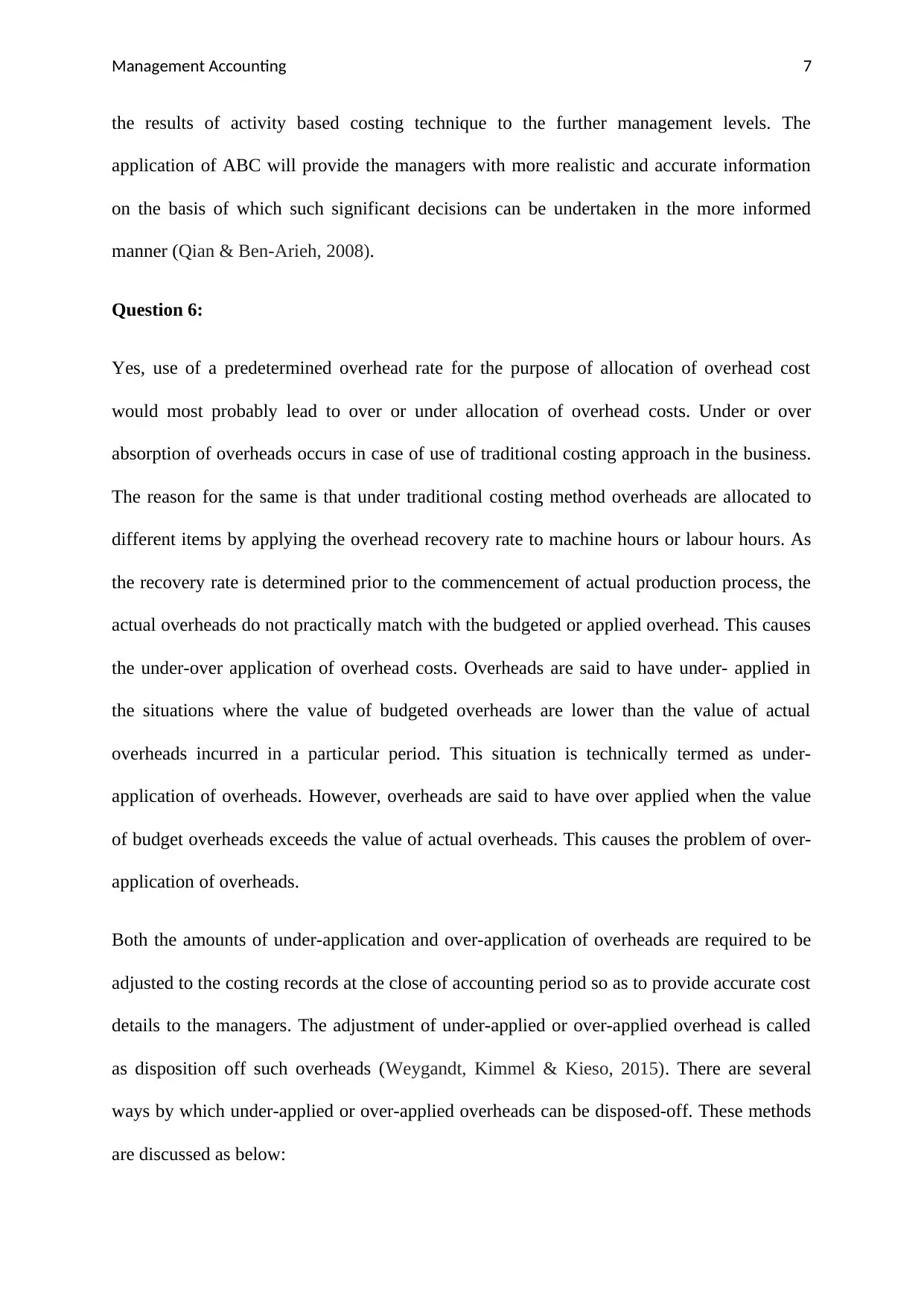
Management Accounting 7
the results of activity based costing technique to the further management levels. The
application of ABC will provide the managers with more realistic and accurate information
on the basis of which such significant decisions can be undertaken in the more informed
manner (Qian & Ben-Arieh, 2008).
Question 6:
Yes, use of a predetermined overhead rate for the purpose of allocation of overhead cost
would most probably lead to over or under allocation of overhead costs. Under or over
absorption of overheads occurs in case of use of traditional costing approach in the business.
The reason for the same is that under traditional costing method overheads are allocated to
different items by applying the overhead recovery rate to machine hours or labour hours. As
the recovery rate is determined prior to the commencement of actual production process, the
actual overheads do not practically match with the budgeted or applied overhead. This causes
the under-over application of overhead costs. Overheads are said to have under- applied in
the situations where the value of budgeted overheads are lower than the value of actual
overheads incurred in a particular period. This situation is technically termed as under-
application of overheads. However, overheads are said to have over applied when the value
of budget overheads exceeds the value of actual overheads. This causes the problem of over-
application of overheads.
Both the amounts of under-application and over-application of overheads are required to be
adjusted to the costing records at the close of accounting period so as to provide accurate cost
details to the managers. The adjustment of under-applied or over-applied overhead is called
as disposition off such overheads (Weygandt, Kimmel & Kieso, 2015). There are several
ways by which under-applied or over-applied overheads can be disposed-off. These methods
are discussed as below:
the results of activity based costing technique to the further management levels. The
application of ABC will provide the managers with more realistic and accurate information
on the basis of which such significant decisions can be undertaken in the more informed
manner (Qian & Ben-Arieh, 2008).
Question 6:
Yes, use of a predetermined overhead rate for the purpose of allocation of overhead cost
would most probably lead to over or under allocation of overhead costs. Under or over
absorption of overheads occurs in case of use of traditional costing approach in the business.
The reason for the same is that under traditional costing method overheads are allocated to
different items by applying the overhead recovery rate to machine hours or labour hours. As
the recovery rate is determined prior to the commencement of actual production process, the
actual overheads do not practically match with the budgeted or applied overhead. This causes
the under-over application of overhead costs. Overheads are said to have under- applied in
the situations where the value of budgeted overheads are lower than the value of actual
overheads incurred in a particular period. This situation is technically termed as under-
application of overheads. However, overheads are said to have over applied when the value
of budget overheads exceeds the value of actual overheads. This causes the problem of over-
application of overheads.
Both the amounts of under-application and over-application of overheads are required to be
adjusted to the costing records at the close of accounting period so as to provide accurate cost
details to the managers. The adjustment of under-applied or over-applied overhead is called
as disposition off such overheads (Weygandt, Kimmel & Kieso, 2015). There are several
ways by which under-applied or over-applied overheads can be disposed-off. These methods
are discussed as below:
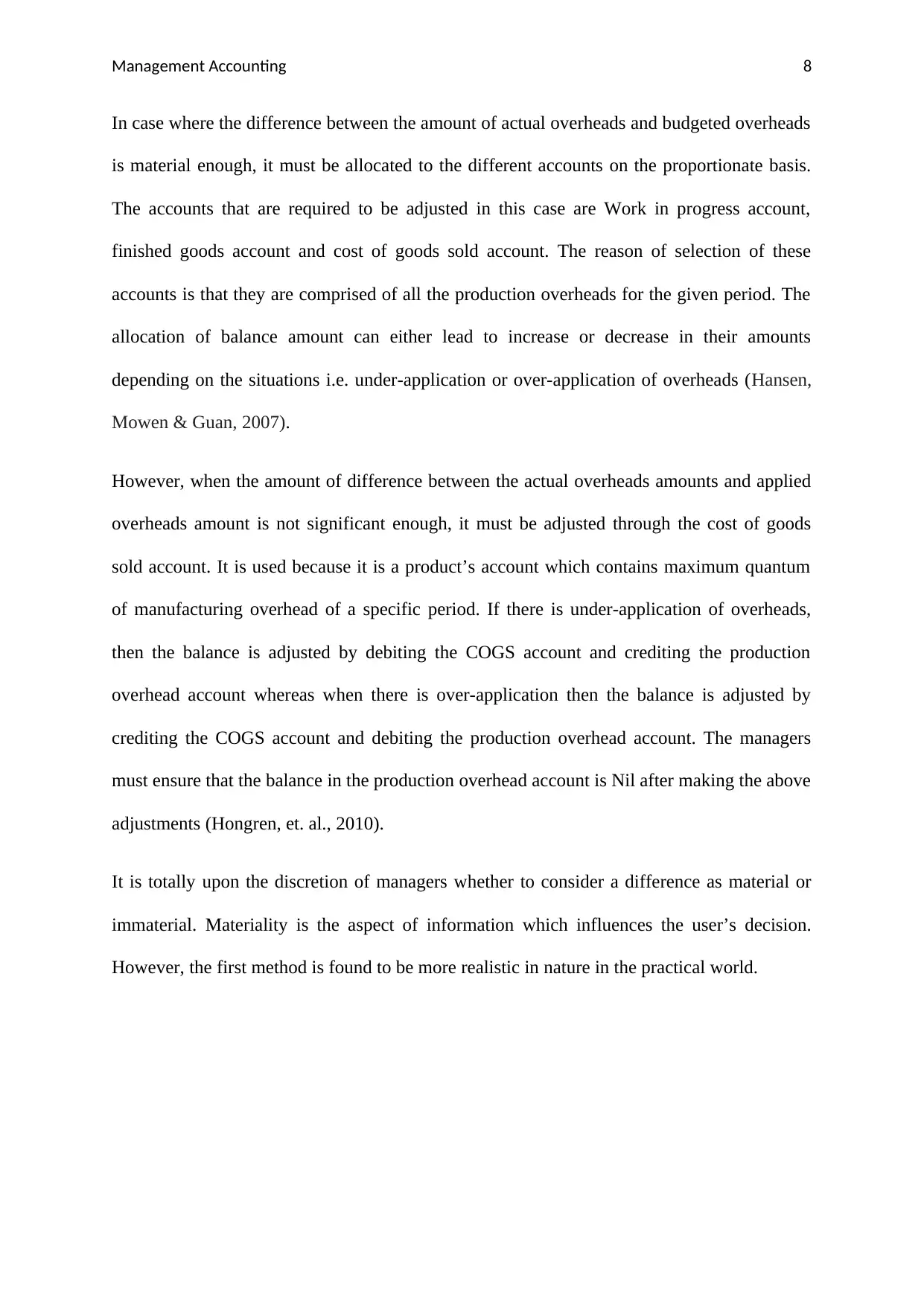
Management Accounting 8
In case where the difference between the amount of actual overheads and budgeted overheads
is material enough, it must be allocated to the different accounts on the proportionate basis.
The accounts that are required to be adjusted in this case are Work in progress account,
finished goods account and cost of goods sold account. The reason of selection of these
accounts is that they are comprised of all the production overheads for the given period. The
allocation of balance amount can either lead to increase or decrease in their amounts
depending on the situations i.e. under-application or over-application of overheads (Hansen,
Mowen & Guan, 2007).
However, when the amount of difference between the actual overheads amounts and applied
overheads amount is not significant enough, it must be adjusted through the cost of goods
sold account. It is used because it is a product’s account which contains maximum quantum
of manufacturing overhead of a specific period. If there is under-application of overheads,
then the balance is adjusted by debiting the COGS account and crediting the production
overhead account whereas when there is over-application then the balance is adjusted by
crediting the COGS account and debiting the production overhead account. The managers
must ensure that the balance in the production overhead account is Nil after making the above
adjustments (Hongren, et. al., 2010).
It is totally upon the discretion of managers whether to consider a difference as material or
immaterial. Materiality is the aspect of information which influences the user’s decision.
However, the first method is found to be more realistic in nature in the practical world.
In case where the difference between the amount of actual overheads and budgeted overheads
is material enough, it must be allocated to the different accounts on the proportionate basis.
The accounts that are required to be adjusted in this case are Work in progress account,
finished goods account and cost of goods sold account. The reason of selection of these
accounts is that they are comprised of all the production overheads for the given period. The
allocation of balance amount can either lead to increase or decrease in their amounts
depending on the situations i.e. under-application or over-application of overheads (Hansen,
Mowen & Guan, 2007).
However, when the amount of difference between the actual overheads amounts and applied
overheads amount is not significant enough, it must be adjusted through the cost of goods
sold account. It is used because it is a product’s account which contains maximum quantum
of manufacturing overhead of a specific period. If there is under-application of overheads,
then the balance is adjusted by debiting the COGS account and crediting the production
overhead account whereas when there is over-application then the balance is adjusted by
crediting the COGS account and debiting the production overhead account. The managers
must ensure that the balance in the production overhead account is Nil after making the above
adjustments (Hongren, et. al., 2010).
It is totally upon the discretion of managers whether to consider a difference as material or
immaterial. Materiality is the aspect of information which influences the user’s decision.
However, the first method is found to be more realistic in nature in the practical world.
⊘ This is a preview!⊘
Do you want full access?
Subscribe today to unlock all pages.

Trusted by 1+ million students worldwide

Management Accounting 9
References:
Accounting Professional and Ethical Standards Board (APESB), 2013. APES 110 Code of
Ethics for Professional Accountants.
Al-Omiri, M. and Drury, C., 2007. A survey of factors influencing the choice of product
costing systems in UK organizations. Management accounting research, 18(4), pp.399-424.
Anderson, S.W., Hesford, J.W. and Young, S.M., 2002. Factors influencing the performance
of activity based costing teams: a field study of ABC model development time in the
automobile industry. Accounting, Organizations and Society, 27(3), pp.195-211.
Armstrong, M.B., Ketz, J.E. and Owsen, D., 2003. Ethics education in accounting: Moving
toward ethical motivation and ethical behavior. Journal of Accounting education, 21(1), pp.1-
16.
Askarany, D., Yazdifar, H. and Askary, S., 2010. Supply chain management, activity-based
costing and organisational factors. International journal of production economics, 127(2),
pp.238-248.
Baxendale, S.J., 2001. Activity-based costing for the small business: A primer. Business
Horizons, 44(1), pp.61-61.
Brierley, J.A., 2008. Toward an understanding of the sophistication of product costing
systems. Journal of Management Accounting Research, 20(s1), pp.61-78.
Charles, S.L. and Hansen, D.R., 2008. An evaluation of activity-based costing and functional-
based costing: A game-theoretic approach. International Journal of Production
Economics, 113(1), pp.282-296.
References:
Accounting Professional and Ethical Standards Board (APESB), 2013. APES 110 Code of
Ethics for Professional Accountants.
Al-Omiri, M. and Drury, C., 2007. A survey of factors influencing the choice of product
costing systems in UK organizations. Management accounting research, 18(4), pp.399-424.
Anderson, S.W., Hesford, J.W. and Young, S.M., 2002. Factors influencing the performance
of activity based costing teams: a field study of ABC model development time in the
automobile industry. Accounting, Organizations and Society, 27(3), pp.195-211.
Armstrong, M.B., Ketz, J.E. and Owsen, D., 2003. Ethics education in accounting: Moving
toward ethical motivation and ethical behavior. Journal of Accounting education, 21(1), pp.1-
16.
Askarany, D., Yazdifar, H. and Askary, S., 2010. Supply chain management, activity-based
costing and organisational factors. International journal of production economics, 127(2),
pp.238-248.
Baxendale, S.J., 2001. Activity-based costing for the small business: A primer. Business
Horizons, 44(1), pp.61-61.
Brierley, J.A., 2008. Toward an understanding of the sophistication of product costing
systems. Journal of Management Accounting Research, 20(s1), pp.61-78.
Charles, S.L. and Hansen, D.R., 2008. An evaluation of activity-based costing and functional-
based costing: A game-theoretic approach. International Journal of Production
Economics, 113(1), pp.282-296.
Paraphrase This Document
Need a fresh take? Get an instant paraphrase of this document with our AI Paraphraser
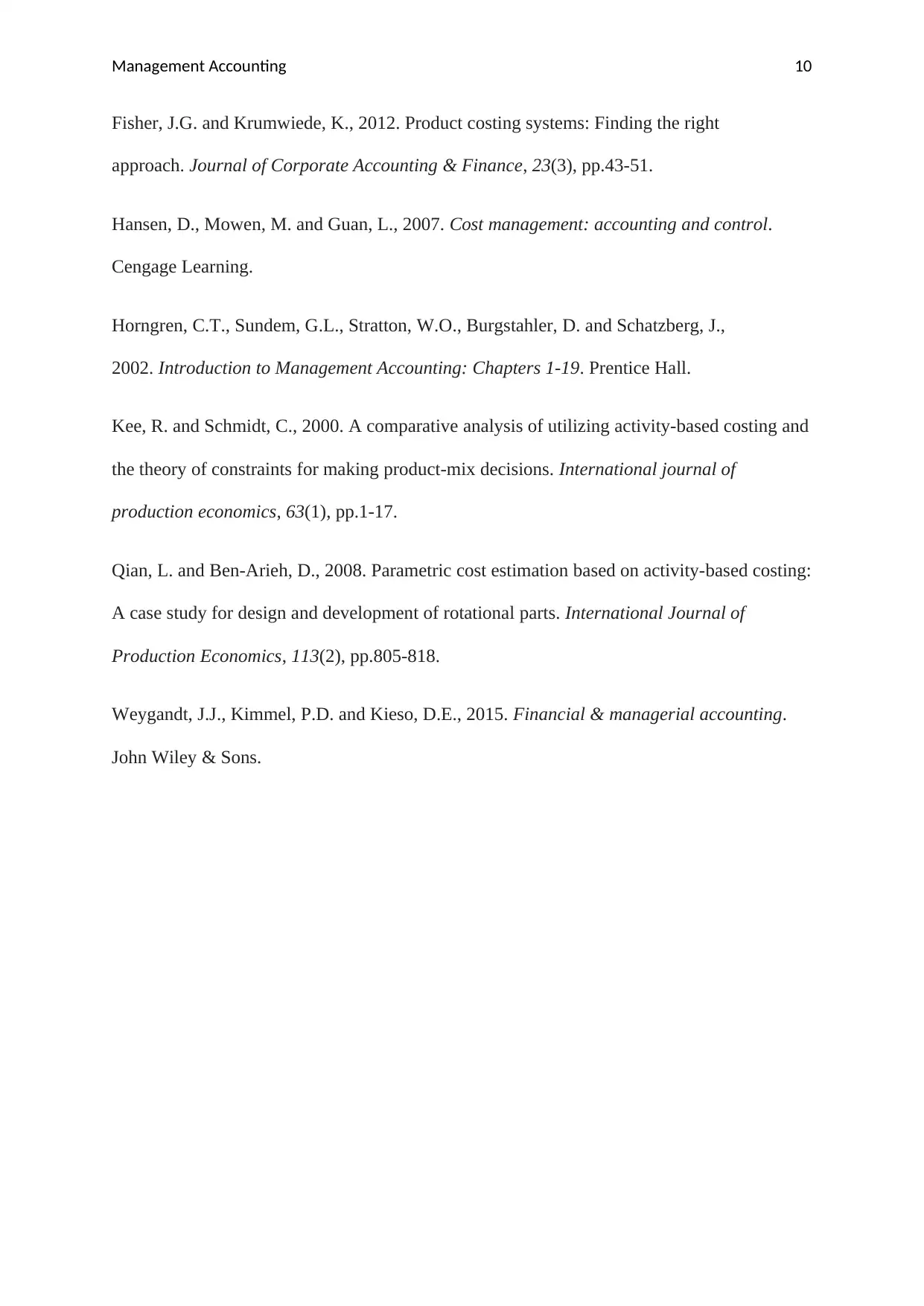
Management Accounting 10
Fisher, J.G. and Krumwiede, K., 2012. Product costing systems: Finding the right
approach. Journal of Corporate Accounting & Finance, 23(3), pp.43-51.
Hansen, D., Mowen, M. and Guan, L., 2007. Cost management: accounting and control.
Cengage Learning.
Horngren, C.T., Sundem, G.L., Stratton, W.O., Burgstahler, D. and Schatzberg, J.,
2002. Introduction to Management Accounting: Chapters 1-19. Prentice Hall.
Kee, R. and Schmidt, C., 2000. A comparative analysis of utilizing activity-based costing and
the theory of constraints for making product-mix decisions. International journal of
production economics, 63(1), pp.1-17.
Qian, L. and Ben-Arieh, D., 2008. Parametric cost estimation based on activity-based costing:
A case study for design and development of rotational parts. International Journal of
Production Economics, 113(2), pp.805-818.
Weygandt, J.J., Kimmel, P.D. and Kieso, D.E., 2015. Financial & managerial accounting.
John Wiley & Sons.
Fisher, J.G. and Krumwiede, K., 2012. Product costing systems: Finding the right
approach. Journal of Corporate Accounting & Finance, 23(3), pp.43-51.
Hansen, D., Mowen, M. and Guan, L., 2007. Cost management: accounting and control.
Cengage Learning.
Horngren, C.T., Sundem, G.L., Stratton, W.O., Burgstahler, D. and Schatzberg, J.,
2002. Introduction to Management Accounting: Chapters 1-19. Prentice Hall.
Kee, R. and Schmidt, C., 2000. A comparative analysis of utilizing activity-based costing and
the theory of constraints for making product-mix decisions. International journal of
production economics, 63(1), pp.1-17.
Qian, L. and Ben-Arieh, D., 2008. Parametric cost estimation based on activity-based costing:
A case study for design and development of rotational parts. International Journal of
Production Economics, 113(2), pp.805-818.
Weygandt, J.J., Kimmel, P.D. and Kieso, D.E., 2015. Financial & managerial accounting.
John Wiley & Sons.
1 out of 11
Related Documents
Your All-in-One AI-Powered Toolkit for Academic Success.
+13062052269
info@desklib.com
Available 24*7 on WhatsApp / Email
![[object Object]](/_next/static/media/star-bottom.7253800d.svg)
Unlock your academic potential
© 2024 | Zucol Services PVT LTD | All rights reserved.





